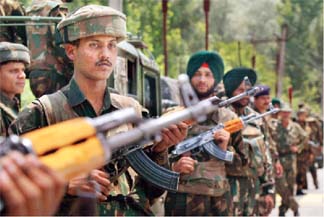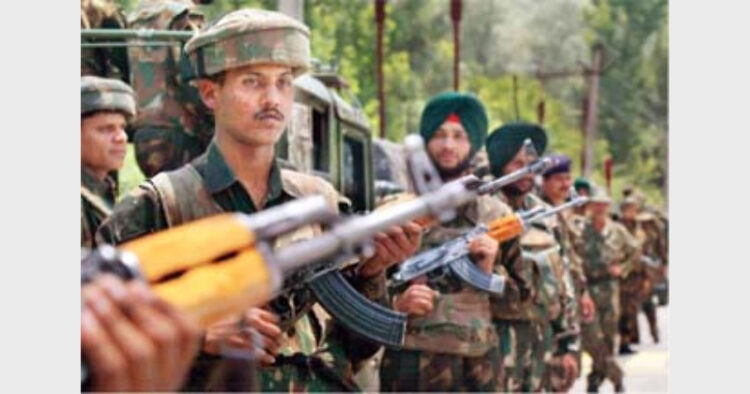 The “far-reaching” revamp is aimed at improving Army’s tooth-to-tail ratio—the number of personnel (tail) required to support a combat soldier (tooth)
The “far-reaching” revamp is aimed at improving Army’s tooth-to-tail ratio—the number of personnel (tail) required to support a combat soldier (tooth)
In a major reform to make the Army ready for fighting modern day warfare, the Centre on August 30, 2017, approved redeployment of 57,000 officers and jawans for combat role by restructuring some services. These changes were recommended by a high-powered Committee headed by Lt General(retd) DB Shekatkar to improve “teeth to tail ratio”.
The Army currently deploys more soldiers on non-combat administrative and supply chain duties than in the trenches in wartime.
In the report, Shekatkar had recommended 99 measures to cut down flab and reduce revenue (maintenance) expenditure so as to modernise the Armed Forces at a faster pace with additional funds at their
disposal. At present, they are left with just 20 per cent of the overall all Defence budget to cater to capital acquisitions. This explains why the drive to modernise the Armed Forces at a faster pace used to get a backseat till now, but not any longer, especially once the recommendations made by Shekatkar Committee are implemented on the ground. It must, therefore, be implemented at a war footing.
While announcing the decision after the Cabinet meeting, the then Defence Minister Arun Jaitley said 65 out of 99 recommendations had been accepted by the Government. More pertinently, while 65 measures of the Committee pertained to the Army, the remaining proposals focus on the Indian Air Force (IAF), Navy and Integrated Defence Staff (IDS).
Shekatkar hoped that the remaining would also be implemented as “they too were very significant”. Those recommendations relate to the Military Engineer Services, Defence Research and Development Organisation, Directorate General of Quality Assurance, Directorate General of Defence Estates, the Ordnance Factory Board and defence accounts.
Jaitley said perhaps for the first time after Independence, such a big and “far-reaching” reform process was being initiated in the Army. While replying to a question by a journalist that whether the exercise was
undertaken keeping in view the Doklam episode, Jaitley said that, “This is not specific to any incident. It had been going on much prior to Doklam.”
It is being widely reported that the Army has recommended the implementation of 80 reforms. We all know that the Army’s massive manpower – some 38,000 officers and 1.1 million soldiers have been a drain on its budget leaving insufficient money for equipment modernisation. The pressure to restructure manpower has increased over the last decade, with the Army adding 80,000-90,000 soldiers for two new mountain divisions and a mountain strike corps for the China border. This alone explains why the 57,000 troops saved by the new reforms could be redeployed to these organisations.
To put things in perspective, apart from restructuring various services of the Army including Signals, Workshop bases, Transport units and Ordinance depots, the Government also accepted the Committee recommendation on improving the National Cadet Corps (NCC). It is noteworthy that officers of the three Services, besides non- commissioned personnel, are posted to the NCC and efforts will be from now onwards to recruit ex-servicemen to man it and free the serving personnel for active duty thereby adding immensely to the operational
capabilities of the armed forces. More serving personnel would thus be available to fight the enemies in case of war which would certainly boost more the fighting strength of our armed forces!
The Government approved optimisation of Signals Establishments to include Radio Monitoring Companies, Corps Air Support Signal Regiments, Air Formation Signal Regiments, Composite Signal Regiments and merger of Corps Operating and Engineering Signal Regiments. The other steps include restructuring of repair echelons in the Army to include Base Workshops, Advance Base Workshops and Static and Station Workshops in the Field Army.
The changes in Ordnance echelons will include Vehicle Depots, Ordnance Depots and Central Ordnance Depots apart from streamlining inventory control mechanisms. Other wings covered in the reform drive include Supply and Transport echelons and Animal Transport units with a focus on better utilisation of these resources. As regards military farms, the process is already on to close them. At present, there are 39 such farms all over the country and 12 of them have already shut down.
These farms were set up during the British rule in the Cantonments located far outside towns with the aim to provide basic necessities to people living inside these establishments. Similarly, the Government has decided to close Army postal establishments in peace locations as means of communications have improved thereby allowing the troops to remain in touch with their respective families.
As things stand, the restructuring would be completed by December 2019. The Army has around 40,525 officers and 1.15 million other ranks. While announcing the government’s decision to usher in the much-needed reforms, Defence Minister Arun Jaitley told media after a Cabinet meeting the “far-reaching” revamp was aimed at improving Army’s tooth-to-tail ratio—the number of personnel (tail) required to support a combat soldier (tooth).
It is indisputable that the Army currently deploys more soldiers on non-combat administrative and supply chain duties than in the trenches in wartime. Improving the ‘teeth to tail ratio’ involves whittling down administrative and logistic units that support combat operations, and redeploying the manpower thus saved into combat units. To increase what the defence ministry terms the Army’s ‘teeth to tail ratio’ by putting a larger percentage of soldiers on the frontline, Defence Minister Arun Jaitley ordered 65 reforms to the structure of the military. The Committee found that the current teeth-to-tail ratio is an unsatisfactory 1:1.5 which means that every 100 combatants directly fighting the enemy had 115 soldiers supporting them logistically and administratively and desired teeth-to-tail ratio which the Committee aims to improve is 1:1 or better. India’s military history. Lt Gen DB Shekatkar (retd) who is head of the panel said that “This is the first time a Committee’s recommendations on military restructuring have been implemented.” He also hailed the revamp saying it would boost the Army’s “combat potential, capability and endurance”. The Committee has rightly suggested that, if implemented over the next five years, the recommendations can result in savings of up to Rs 25,000 crore in defence expenditure. It has also rightly suggested enhancing standards for recruitment of clerical staff and drivers.
Some key recommendations that have not been accepted include, enhancing defence budget from current 2% of GDP to 2.5-3% of GDP, early appointment of four-star officer as tri-service commander,setting up tri-service ‘theatre commands’ with units from Army, Navy and Air Force, setting up cyber command for new-generation warfare and institution of ‘roll-on-plan’ for unspent budget to devolve to the subsequent year.
(The writer is a Meerut-based advocate)














Comments